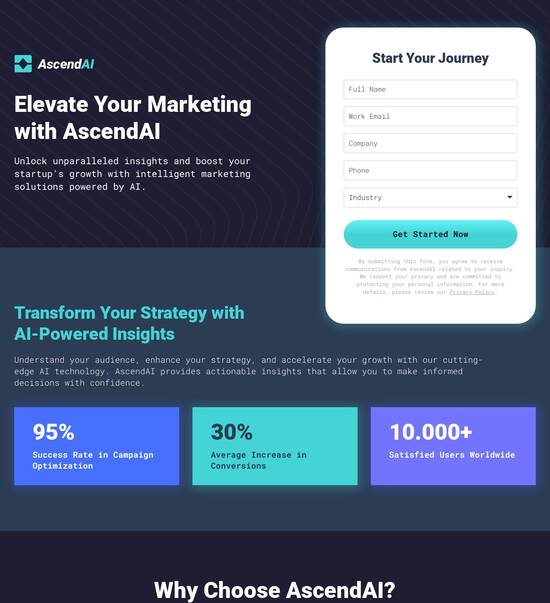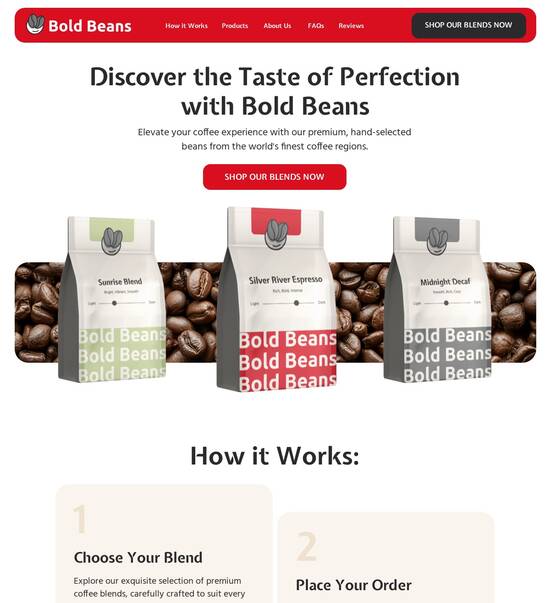
Onboarding page template for E-commerce business analysts
Explore Similar TemplatesAbout template
Master your online marketing with this builder for onboarding page template for E-commerce business analysts. Try more tools to create an immaculate landing page.
Recommended templates

Easy to build without coding
With the intuitive drag-and-drop builder, anyone on your team can create high-converting pages without any knowledge of code or design. Make enhancements to your landing page with custom widgets using Javascript, HTML/CSS, or third-party scripts.

Multiple layouts for any industry and goal
Select from 500+ landing page layouts built to boost conversions across industry-specific scenarios. Customize them by adjusting fonts, adding images, and generating on-brand content with the AI assistant. Quickly scale with Instablocks® and Global Blocks that you can save, reuse, and update globally.

Loads fast and looks polished on any device
Every template is responsive, which means they present professionally on any device and load blazingly fast with our Thor Render Engine. You can also power them up with Google AMP technology to deliver an unparalleled mobile experience and drive higher conversions.

Robust analytics & experimentation
Get real-time updates and reporting across all your devices, showing the number of visitors, conversions, cost-per-visitor, and cost-per-lead. Launch AI-powered experiments, run A/B tests, and use heatmaps to analyze user behavior, then optimize your landing page to maximize conversions.







Easy to build without coding
With the intuitive drag-and-drop builder, anyone on your team can create high-converting pages without any knowledge of code or design. Make enhancements to your landing page with custom widgets using Javascript, HTML/CSS, or third-party scripts.
Multiple layouts for any industry and goal
Select from 500+ landing page layouts built to boost conversions across industry-specific scenarios. Customize them by adjusting fonts, adding images, and generating on-brand content with the AI assistant. Quickly scale with Instablocks® and Global Blocks that you can save, reuse, and update globally.
Loads fast and looks polished on any device
Every template is responsive, which means they present professionally on any device and load blazingly fast with our Thor Render Engine.
Robust analytics & experimentation
Get real-time updates and reporting across all your devices, showing the number of visitors, conversions, cost-per-visitor, and cost-per-lead. Launch AI-powered experiments, run A/B tests, and use heatmaps to analyze user behavior, then optimize your landing page to maximize conversions.
All the features you need to build ecommerce onboarding
Explore more featuresLearn how to build marketing onboarding template
Frequently asked questions about digital marketing client onboarding checklist template
Leading the way in building high-performing landing pages





Ecommerce customer onboarding: Your ultimate how-to guide
A compelling onboarding page template is crucial for e-commerce business analysts looking to enhance user engagement and streamline the customer journey. Utilizing Instapage's high-converting landing page templates ensures that your onboarding experience is both efficient and impactful.
Understanding the importance of an onboarding page
Onboarding pages serve as the first interaction point, making it vital for e-commerce platforms to optimize this experience. A well-designed template can significantly reduce drop-off rates and improve conversion metrics. Key components of an effective onboarding page include clarity, guidance, and easy navigation. This approach fosters a positive first impression and encourages users to actively engage with your brand.
- User guidance: Clearly explain what the user can achieve on your platform.
- Visual appeal: Use engaging visuals and layout to capture user attention.
- Metrics tracking: Implement tracking tools to assess user engagement and identify areas for improvement.
Step 1: Choosing the right template for onboarding
Selecting a tailored onboarding template is the first critical step. Consider factors such as your audience's demographics, the complexity of your offerings, and essential features you want to highlight.
- Customization options: Choose a template that allows for personalization to reflect your brand identity.
- Responsive design: Ensure the template functions seamlessly on all devices.
- Integrated tools: Look for templates that come with built-in analytics for tracking performance.
Step 2: Implementing lead generation elements
Incorporating lead generation elements within your onboarding page is essential for capturing user information. Utilize intuitive forms, CTAs, and engaging content.
- Clear CTAs: Utilize strong, action-oriented calls to action that guide users toward the next steps.
- Lead capture forms: Simple forms that require minimal information can optimize conversion rates.
- Content personalization: Adapt content based on user behavior data to enhance relevancy.
Step 3: Testing and optimizing for performance
Once your onboarding page is live, conducting A/B testing is crucial. This process allows you to evaluate different elements and optimize for performance based on real user data.
- A/B testing: Test variations of headlines, layouts, and CTA placement to discover optimal configurations.
- Heatmaps: Use heatmaps to analyze user interactions and refine your designs accordingly.
- Feedback loop: Regularly collect user feedback to identify pain points and areas for enhancement.
Optimizing your onboarding page will significantly impact user retention and engagement, laying the foundation for a successful e-commerce strategy.
Ready to elevate your onboarding experience? Start creating your e-commerce onboarding page with Instapage today and harness the power of dedicated templates to boost your conversions!
People also ask about onboarding ecommerce
Onboarding page template for e-commerce business analysts
Understanding the role of e-commerce business analysts
E-commerce business analysts play a crucial role in bridging the gap between technology, analytics, and business strategy. They focus on understanding the drivers of e-commerce performance, ensuring that businesses not only collect data but also utilize it effectively for decision-making. Core responsibilities include monitoring key performance indicators (KPIs), conducting market analysis, and collaborating with cross-functional teams to enhance the customer experience and optimize sales.
The importance of data-driven decision-making cannot be overstated. E-commerce analysts need to assess data trends to influence product offerings, pricing strategies, and marketing initiatives. Their insights guide strategic planning and ensure that businesses remain competitive in a rapidly evolving market.
Analytical skills to interpret data and draw actionable conclusions.
Familiarity with digital marketing strategies and financial principles.
Technical expertise with tools such as JavaScript and project management methodologies.
The significance of an effective onboarding page
An onboarding page serves as the first point of interaction for new users with a platform. First impressions are incredibly important; a well-designed onboarding page can significantly boost user engagement and retention. Users are more likely to return if they feel welcomed and informed from their initial experience. As such, an onboarding page should not be just an informational tool, but also a platform for interaction and engagement.
Metrics like time spent on the page, bounce rates, and user feedback are crucial for measuring initial user engagement. Businesses should monitor these metrics diligently to refine their onboarding strategies continually. A structured onboarding process results in not only faster acclimatization to platform functionalities but also increases user retention rates by providing a clear path for new users.
Components of an e-commerce onboarding page template
An effective onboarding page template should encompass several critical components to facilitate a seamless user experience. Firstly, providing a comprehensive navigation overview helps users find their way around the platform quickly. This includes easy access to various features, resources, and help options, which enhances user satisfaction.
Next, detailing product features and capabilities is key. Highlighting crucial functionalities, including AI capabilities, allows users to understand the full range of offerings. Encouraging user interaction is vital as well; implementing JavaScript for dynamic interactions can lead to a more engaging experience. Lastly, visual aids—like flowcharts and org charts—enable clearer communication of complex information, making it easier for users to digest.
Navigation overview that promotes intuitive use.
Highlight key product features, including advanced AI functionalities.
Visual representations like flowcharts to simplify information.
Tailoring the onboarding experience
Understanding user segments is essential for creating an effective onboarding experience. Business analysts must define audience categories based on demographic, psychographic, and behavioral data. By identifying what drives each segment's purchasing decisions, analysts can tailor the onboarding experience, enhancing user satisfaction and overall engagement.
Furthermore, personalized strategies should be implemented based on the specific business model. For instance, startups may need a more hands-on approach to guide users through the platform features, while established businesses might focus on refining existing functionalities based on user feedback. Integration with broader financial and marketing strategies can ensure that onboarding aligns with overall business goals.
Tools and technologies for creating onboarding pages
Utilizing the right tools and technologies can dramatically enhance the efficacy of onboarding processes. AI-powered tools are particularly beneficial, streamlining user interactions and providing real-time insights into performance. They enable e-commerce platforms to enhance user experiences through automated assistance and personalized content recommendations.
Project management software also plays a pivotal role in organizing onboarding effectively. Using dashboards for roadmap management and incorporating Gantt charts can help teams visualize the onboarding process's timeline. This organization ensures clarity in task delegation and project tracking, making the onboarding process efficient and manageable.
AI-powered tools for enhancing user experience and personalization.
Project management software for effective onboarding organization.
Developing a structured onboarding process
Designing a structured onboarding process involves identifying key touchpoints in the user journey. Understanding these touchpoints allows business analysts to create a coherent roadmap that guides users from initial engagement through to becoming proficient users. Additionally, budgeting for onboarding initiatives is crucial to allocate resources effectively. This ensures that every stage of the onboarding process is well-supported.
Moreover, implementation and feedback mechanisms are vital for continuous improvement. Gathering user feedback on their onboarding experience provides insights into what is working and what needs refinement. This feedback loop can help analysts adjust the onboarding content using analytics data to enhance user experience further.
Aligning onboarding with business goals
To maximize the impact of an onboarding page, it must align with the organization's digital marketing strategy. It should seamlessly fit into the overall marketing plan, ensuring that every new user is not only onboarded but also introduced to ongoing marketing campaigns and promotions. Case studies showcasing successful onboarding initiatives illustrate how well-aligned strategies lead to increased conversions and enhanced customer satisfaction.
Cybersecurity considerations should also not be overlooked. Ensuring that user data is protected during the onboarding process is essential for maintaining trust. Implementing best practices for secure onboarding processes—such as encryption and compliance with data protection regulations—fortifies the connection users develop with a brand.
Creating compelling presentations for internal buy-in
When it comes to presenting onboarding strategies to stakeholders, crafting effective pitch interviews is critical. A solid business case for onboarding processes should clearly outline objectives, potential benefits, and expected outcomes. Engaging stakeholders requires not just presenting the data but also sharing a compelling narrative around how onboarding enhances user experience and satisfaction.
Additionally, utilizing presentation maker tools helps in designing impactful slides that support your onboarding strategy's communication. Incorporating reports and data visualizations into presentations effectively showcases the potential impact of the proposed onboarding initiatives and fosters greater understanding among stakeholders.
Placing continuous improvement at the forefront
Continuous improvement should be integral to the onboarding process. An iterative approach allows e-commerce businesses to adapt their onboarding content based on user feedback. Establishing feedback loops helps identify areas for enhancement, ensuring the onboarding content remains relevant and effective over time.
In addition to user feedback, monitoring trends and innovations in onboarding can provide insights into emerging technologies that could enhance the process further. This proactive approach ensures that businesses stay ahead of the curve, creating adaptable onboarding experiences that meet evolving user expectations.
Summary of insights
In conclusion, an effective onboarding page for e-commerce business analysts is crucial for promoting user engagement, retention, and overall satisfaction. The importance of strategically crafting each component cannot be overstated, as these elements collectively work towards creating a positive user experience.
Leveraging advanced technologies, understanding user segments, and refining strategies based on analytics data all contribute to creating a successful onboarding experience. By placing continuous improvement at the forefront, organizations can foster long-lasting relationships with their users, ultimately driving e-commerce success.
Ready to skyrocket conversions?
Supercharge your ad campaigns with high-performing landing pages
Get started














